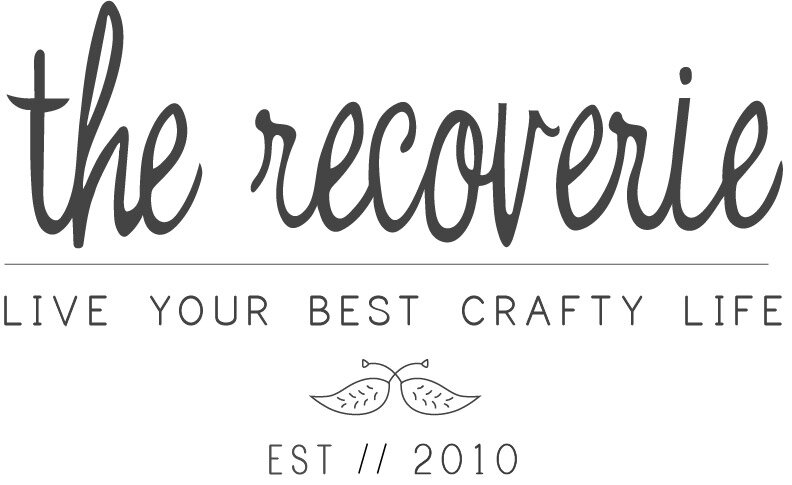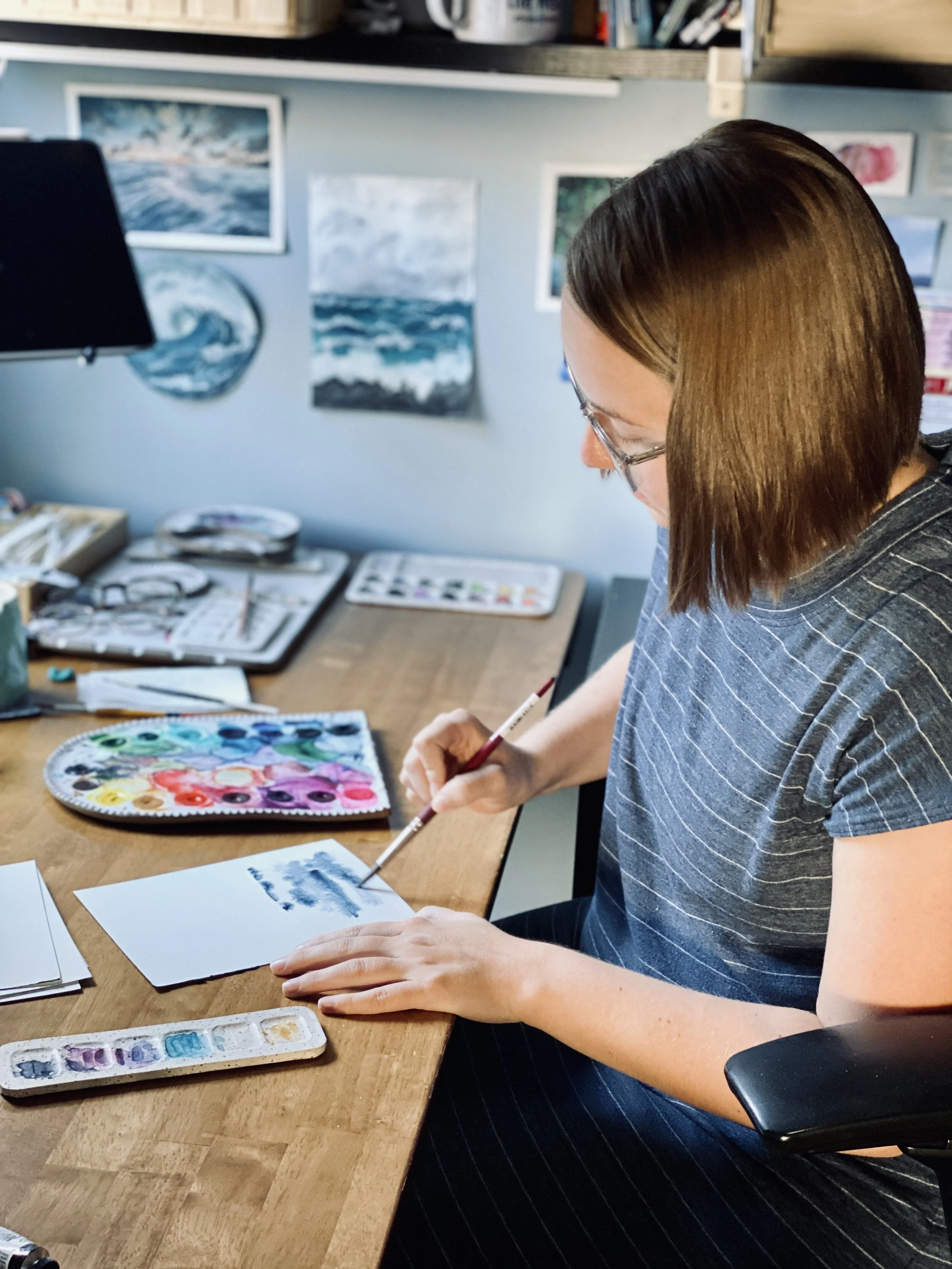Featured Artist: Kolbie From "This Writing Desk" on How She Became a Full Time Artist
As a creative business owner and full time artist, I often stress the importance of surrounding yourself with other types of artists. It’s good to create an inspiring community around you that will keep you moving when you start to doubt yourself.
Whenever I get stuck or discouraged, I just reach out to one of these artist friends, (or make a point to go meet a new one!) and immediately get excited to get back to work!
Today we are meeting the talented Kolbie from “This Writing Desk” who describes herself as an artist and a writer, a wanderer and storyteller.
She is a watercolor artist and course creator, and she also has a brand new book on watercolor techniques.
So without further ado, here’s Kolbie with with how she became a full time artist and creative business owner:
Have you always been an artist? What's your creative background?
Actually, no! I would say I’ve always been a creative, but up until a few years ago, I thought my artistic ability capped out at stick figures. I do have an extensive background in music, theatre, and writing (I majored in English), so creativity has always been a big part of how I express myself.
Then, in 2015, I was working a 9-5 as a writer/editor for the government, and I would spend my lunch breaks mesmerized by calligraphy and watercolor Instagram videos, thinking to myself: “Man, I wish I could do that!”
Eventually, that thought morphed into “Well, why CAN’T I do that? I bet I could try!” So I bought some brush pens and (eventually) some watercolor—and I was terrible at it, just like everyone is at first, haha.
But I LOVED the process so much that I spent hours every evening and weekend just practicing with music or Netflix on in the background while my husband was playing video games or at school (he was in law school at the time).
It didn’t take long for me to realize that art was inside me—I just had to have the courage to take that first step. And now it’s one of the most important parts of my life.
How did you end up becoming a full time artist, start your own business, and get into watercolor?
A couple years after picking up watercolor and calligraphy as a hobby, I decided to start an Etsy shop to help pay for supplies, but I had no intention of quitting my 9-5 (which I liked a lot!).
Still, after a few months running that little Etsy shop, I realized that painting and art were all I could think about, even at work. So I researched how to start a business and saved up some money, and about a year later, I quit my job!
There have been a lot of ups and downs, and it hasn’t been anything like I expected, but I wouldn’t change it for the world.
One of my favorite parts of owning my own business is having the freedom to let creativity be such a big part of my strategy.
I started by mostly selling originals and a few prints, and then I made a Skillshare class kind of on a whim—and that choice was the reason I fully committed to leaving my 9-5. I love teaching just as much as I love painting, and it’s been wonderful to meld the two.
What's your process like when you start a new painting?
Every painting is different. Sometimes, I take a look at some beautiful photos. Sometimes, I listen to some music or immerse myself in a beautiful story.
Either way, I start by letting my emotions and memories bubble to the surface—because I firmly believe that art is all about expressing how you feel and sharing it with the world. Once I have a general vibe ready, I’m usually ready to get out my supplies.
Then, I piece together what I’m going to do. Sometimes, I have a specific idea in mind (whether I’m using a reference photo or coming up with my own design), so I map out the painting by layers in my head and piece it together like a puzzle. (That’s my big secret to mastering watercolor landscapes—it’s all about the layers!)
Other times, I just kind of let the painting emerge with no real clear idea except for a basic color palette. This technique is a little trickier because it takes a lot of self-compassion and a willingness to view messes more as opportunities for creativity.
I know it sounds dreamy to just paint in the creative flow and watch as beauty comes through, but it’s not always as serene or magical as that if you have a hard time with control and expectations.
I’ve made a lot of messes, recycled a lot of paper, and walked away really frustrated with myself! But making those messes has taught me a lot about seeing the beauty in the unexpected, and that often makes all the difference when going into a piece without a clear direction.
The more you get comfortable with uncertainty and the risk of failure, the further into your creativity you can go.
You just put out a new book on watercolor, tell us a little bit about it.
Wilderness Watercolor Landscapes is my love letter to the imperfect power of the wilderness, the magic of watercolor, and to five-years-ago me.
As I mentioned before, I had no idea that art was the path I would take—I thought I was terrible at it! But it is so much more approachable and life-changing than I initially thought, and I created this book to help other people like me who may be getting in their own way when it comes to creativity.
My book has seven chapters: the first chapter is all about watercolor basics, with a rundown of my favorite supplies, a little bit of color theory, and my favorite wilderness techniques (like painting trees, mountains, mist, etc).
The next six chapters are all filled with step-by-step landscapes scenes that start pretty simple and build in complexity! My goal is for even the absolute beginner to pick up the book and work their way through to some pretty magical and complex pieces.
And since I’m also a writer by trade, I worked hard to make sure the instructions are packed with clear information without being too wordy.
I also include a lot of encouraging language about the power of imperfection and how to approach watercolor with a heavy dose of self-compassion, viewing it as a process rather than a product. That’s something a lot of my readers have loved!
More than anything, I wanted to create something that would give any artist ample opportunity and inspiration to give painting the wilderness a chance—because I know how magical it feels.
You also teach workshops and do virtual classes, what kinds of projects do you usually teach?
I mostly focus on landscape scenes, but I also teach some florals and basic watercolor techniques!
You can find tutorials from me on YouTube and Skillshare, and my signature watercolor beginner’s course (Exploring Watercolor 101) will be open for enrollment again in early 2021.
What artists and designers inspire your style?
Ooh, so many. I think the best artists are a conglomeration of all of their favorite things! This is not a complete list, but here are some Instagram accounts I love and am inspired by: Morgan Harper Nichols, Daneille Lanslots, Emily Jeffords, Trupti Karjinni, Laurie Gonzalez, Maria Smirnova, Melissa Koby, Dan Lee, Elizabeth Gray, Rosalie Haizlett, Riley Sheehay, Sarah Cray, Joey Merryl…honestly, I could go on for pages and pages!
What have you found to be the most difficult part about running your own full time art business? The most rewarding?
The hardest part is definitely wearing all of the hats. I’m a solopreneur right now, so I do EVERYTHING.
I’m constantly exhausted, and I used to have a lot of guilt over how slow it is to really get going when you’re doing it all yourself (especially since I only do the creating part maybe 20-30% of the time—the rest is taken up with emails, logistics, planning, taxes, and other tiring things!).
I also had a baby in my first year as a full time artist, so it was definitely a struggle learning to manage a newborn with a new business. But the most rewarding part has been allowing myself the room to grow and learn from every moment I’m in.
Running your own business is kind of like baptism by fire—it takes a lot of anxious nights and exhausting days to find your groove, but when you do finally nail a launch or finish that to-do list or spend a whole day painting guilt-free because that’s what the job is, man. It feels amazing.
This job is WAY harder than my 9-5 was, but it’s hard in the best ways for me.
Do you have any new ideas or projects coming up that you’re excited about?
Well, I can’t spill the beans on everything just now, but I have some classes and tutorials focused on GOUACHE that I’m really excited about! In particular, I’m working on a Skillshare class all about using gouache to paint dreamy seascapes that I think everyone’s going to love.
I’m also working on some fun projects that will combine art and watercolor with mindfulness and meditation—more on that in a few months!
What’s your best piece of advice for someone who wants to start doing watercolor but has no previous experience?
Make sure to enjoy it for the process. Watercolor is so magical because it takes you to another world when you’re actually doing it—producing a pretty picture at the end is just a bonus.
Remember: I’ve recycled far more pieces of paper than I’ve kept, and sometimes, I made a mess just because I wanted to watch the colors blend and swirl together with no intention of turning them into something. When you make art about the process and not about product, it’s so much more enjoyable, and it takes the pressure off.
When you’re a beginner, you’re going to make pieces you don’t like. Everyone does!
But the more you can learn to love the creating part, the more you’ll want to practice—and you’ll eventually develop a style that feels so completely you. It’s a lifelong journey that I think everyone should take!
<<>>
Thanks Kolbie for chatting with us and sharing your experience becoming a full time artist!
You can find more about Kolbie and her art here, and if you’re ready to find out how you can make a living by selling your work online too, click the image below to watch my free workshop!













